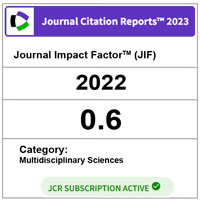A preliminary study of marine water quality status using principal component analysis at three selected mangrove estuaries in East Coast Peninsular Malaysia
DOI:
https://doi.org/10.11113/mjfas.v13n4.693Keywords:
Marine water quality, Mangrove, Estuaries, South China Sea, Principal component analysis,Abstract
This research presents marine water quality status in three different mangrove estuaries. The objective of this study is to evaluate the surface water quality of three estuaries in east coast Peninsular Malaysia. The parameters measured were Dissolved Oxygen (DO), pH, Biochemical Oxygen Demand (BOD), total dissolved solid (TDS), ammonium (NH4-N), turbidity (TUR), total suspended solid (TSS) and coliform. Monthly sampling was performed during the dry season, from June 2016 until September 2016. Data were analysed using principal component analysis (PCA). PCA yielded two PCs where VF1 forms strong factor loadings for pH, NH4-N, SAL, and TDS signifying saltwater intrusion in mangrove area. VF2 designed strong factors of BOD, TUR and Coliform and strong negative loading of DO indicating anthropogenic pollutions in the area. This study output will be a baseline setting for future studies in mangrove estuary marine water quality. Mangrove marine water samples of future monitoring studies in mangrove estuary will benefit by enabling understanding of pollution loading and coastal water quality. It is essential to plan a workable water quality modelling as powerful tool to simulate marine water quality and forecast future consequences to facilitate mangrove biodiversity conservation.
References
Alongi, D. M., McKinnon, A. D., Brinkman, R., Trott, L. A., Undu, M. C., Muawanah and Rachmansyah. (2009). The fate of organic matter derived from small-scale fish cage aquaculture in coastal waters of Sulawesi and Sumatra, Indonesia. Aquaculture. 295(1/2): p. 60-75.
APHA (1998). Standard Methods for the Examination of Waste and Wastewater. American Public Health Association, American Water Works Association and Water Environmental Federation, Washington DC.
Department of Environment, Malaysia (2015). Malaysia Environmental Quality Report 2014. Retrived from http://enviro.doe.gov.my/
Department of Irrigation and Drainage, Malaysia (2015). Laporan Banjir Tahunan 2014 Terengganu. Retrieved from http://jpsweb.terengganu.gov.my/ index.php/ en/laporan-banjir
Dominick, D., Juahir, H., Latif, M. T., Zain, S. M., & Aris, A. Z. (2012). Spatial assessment of air quality patterns in Malaysia using multivariate analysis. Atmospheric Environment. 60: p. 172-181.
Duke, N. C., Meynecke, J. O., Dittmann, S., Ellison, A. M., Anger, K., Berger, U., Cannicci, S., Diele, K., Ewel, K. C., Field, C. D., Koedam, N., Lee, S. Y.,
Marchand, C., Nordhaus, I., Dahdouh-Guebas, F. (2007). A world without mangroves? Science. 317(5834): p. 41-42.
Fashchuk, D. Y. (2011). Geographic and ecological information model of marine basin, In: Marine Ecological Geography. Environmental Science and Engineering. Berlin, Heidelberg: Springer.
Hairoma, N., Gasim, M. B., Azid, A., Muhamad, H., Sulaiman, N. H., Khairuddin, Z., Mustafa,. A. D., Azaman, F., Amran, M. A. (2016). Saltwater intrusion analysis in East Coast of Terengganu using multivariate analysis. Malaysian Journal of Analytical Sciences. 20(5): p. 1225-1232.
Hauff, R. D., Ewel, K. C. and Jack, J. (2006). Tracking human disturbance in mangroves: estimating harvest rates on a Micronesian Island. Wetlands Ecology and Management. 14(2): p. 95-105.
Holguin, G., Vazquez, P. and Bashan, Y. (2001). The role of sediment microorganisms in the productivity, conservation, and rehabilitation of mangrove ecosystems: an overview. Biology and Fertility of Soils. 33(4): p. 265-278.
Ismail, W. R. and Ibrahim, M. N. (2015). An assessment of sediment and nitrogen input into the upper Merbok Estuary, Kedah, Malaysia. Water Quality, Exposure and Health. 7(1): p. 79-88.
Juahir, H., Zain, S. M., Toriman, M. E., Mokhtar, M., Man, H. S. (2004). Application of artificial neural network models for predicting water quality index. Jurnal Kejuruteraan Awam. 16(2): p. 42-55.
Kamaruzzaman, B. Y., Ong, M. C., Noor Azhar, M. S., Shahbudin, S., Jalal, K. C. A. (2009). Accumulation of lead and copper in Rhizophora apiculata from Setiu mangrove forest, Terengganu, Malaysia. Journal of Environmental Biology. 30(5). 821-824
Koh, K., Suratman, S., Mohd Tahir, N. (2015). Dissolved and suspended particulate metals in Setiu River Basin, Terengganu, Malaysia. Sains Malaysiana. 44(7): p. 957-964.
Kumar, S. and Murty, M. (2011). Water pollution in India: An economic appraisal. Indian Infrastructure Report.
Mohd, I., Mansor, M. A., Awaluddin, M. R. A., Nasir, M.F.M., Samsudin, M.S., Juahir H. and Ramli, N. (2011). Pattern recognition of Kedah river water
quality data by implementation of principal component analysis. World Applied Sciences Journal. 14. p. 66-72.
Mumby, P. J. (2004). Mangroves enhance the biomass of coral reef fish communities in the Caribbean. Nature. 427(6974): p. 533-536.
Praveena, S. M. and Aris, A. Z. (2013). A baseline study of tropical coastal water quality in Port Dickson, Strait of Malacca, Malaysia. Marine Pollution
Bulletin. 67(1): p. 196-199.
Sandilyan, S. and Kathiresan, K. (2014). Decline of mangroves–A threat of heavy metal poisoning in Asia. Ocean & Coastal Management. 102: p. 161-168.
Satheeshkumar, P. and Khan, A. B. (2012). Identification of mangrove water quality by multivariate statistical analysis methods in Pondicherry Coast, India. Environmental Monitoring and Assessment. 184(6): p. 3761-3774.
Shaari, H., Mohd, M. S., Abdullah, N. A., Bidai, J. (2015). Heavy metals monitoring in Psammotaea elongata from Semerak Lagoon, Kelantan, Malaysia. Oriental Journal of Chemistry. 31(2): p. 993-999.
Suratman, S. and Hussein, A. N. A. R. and Latif, M.T. and Weston, K. (2014). Reassessment of physico-chemical water quality in Setiu Wetland, Malaysia. Sains Malaysiana. 43(8): p. 1127-1131.
Suratman. S, Hussein, A. N. A. R, Mohd Tahir, N., Latif, M. T., Mostapa, R., Weston, K. (2016). Seasonal and spatial variability of selected surface water quality parameters in Setiu Wetland, Terengganu, Malaysia. Sains Malaysiana. 45(4): p. 551-558.
Tukey, J. W. (1990). Data-based graphics: Visual display in the decades to come. Statistical Science. 5(3): p. 327-339.
Vega, M., Pardo, R., Barrado, E., Deban, L. (2011). Assessment of seasonal and polluting effects on the quality of river water by exploratory data analysis. Water Research. 32(12): p. 3581-3592.
Wong, Y. S., Lan, C. Y., Chen, G. Z., Li, S. H., Chen, X. R., Liu, P. Z., Tam, N. F. Y. (1995). Effect of wastewater discharge on nutrient contamination of mangrove soils and plants. Hydrobiologia. 295(1-3): p. 243-254.







